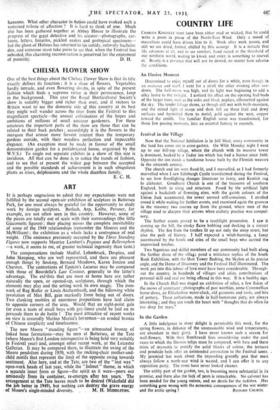Festival in the Village
Now that the National Jubilation is in full blast, every community in the land has come out in cross-garters. On Whit Monday night I went up to our hill-top village, where the church with its massive tower is dominant, backed by a Tudor inn which has had a licence since 1600. Opposite the inn stands a handsome house built by the Flemish weavers in the sixteenth century.
The church and inn were flood-lit, and I marvelled, as I had formerly marvelled when I saw Edinburgh Castle transformed during the Festival, to see how floodlighting changes limestone to ivory, and Kentish rag to alabaster. Goudhurst Church is one of the treasures of southern England, both in siting and structure. Posed by the artificial light against a backcloth of flowering elms, with the garish colours of the Union Jack accentuated, the tower seemed self-conscious. I strolled round it while waiting for further events, and examined again the grooves in the masonry two courses up from the ground, where men of the village used to sharpen their arrows when archery practice was compul- sory.
The further events proved to be a torchlight procession. I saw it coming up the hill, the smoky flares bobbing and ducking in a sinister rhythm. The fire from the torches lit up not only the steep street, but also the path of history. I half expected a witch-burning, a fancy accentuated by the howls and cries of the small boys who carried the improvised torches.
Two ingenious and skilful members of our community had built along the further shore of the villap pond a miniature replica of the South Bank Exhibition, with the Shot Tower flashing, the Skylon at its precise angle, and the Dome of Discovery and the Festival Hall illuminated. The work put into this labour of love must have been considerable. Through- out the country, in hundreds of villages and cities, contributions of personal skill and zeal are being offered in this way. It is a healthy sign.
In the Church Hall was staged an exhibition of relics, a few flakes of the snows of yesteryear ; photographs of past worthies, some Cromwellian horse-shoes, an Elizabethan water-clock, old garments and tools, and bits of pottery. These collections, made in half-humorous piety, are always interesting ; and they can touch the heart with "thoughts that do often lie too deep for tears."


































 Previous page
Previous page